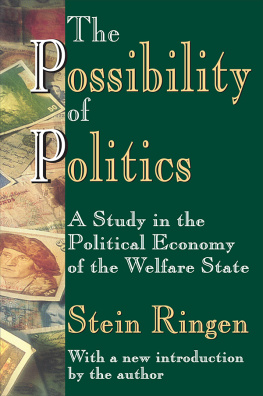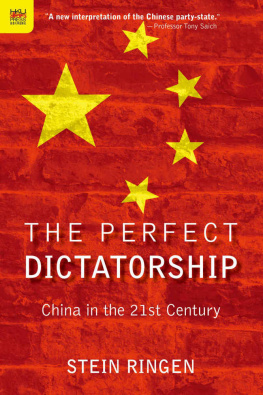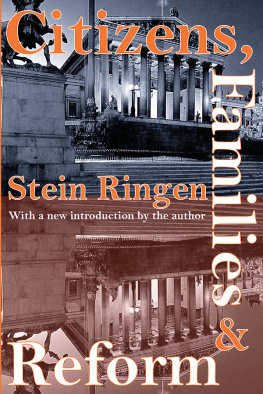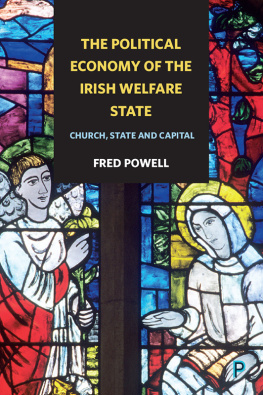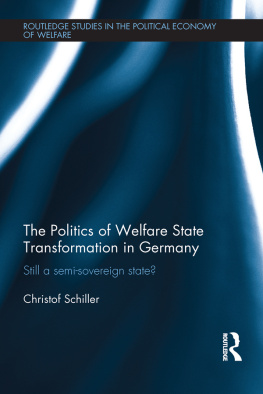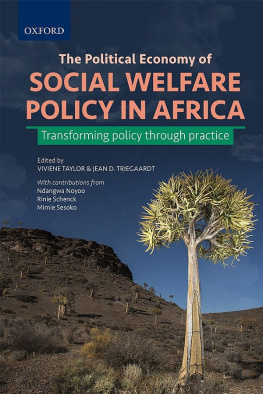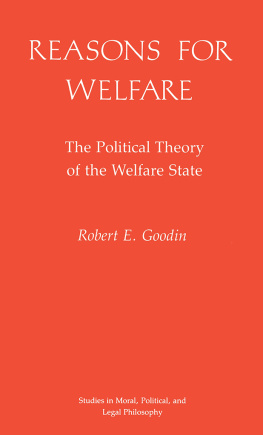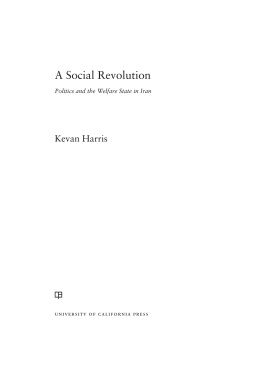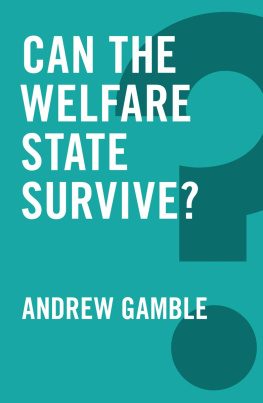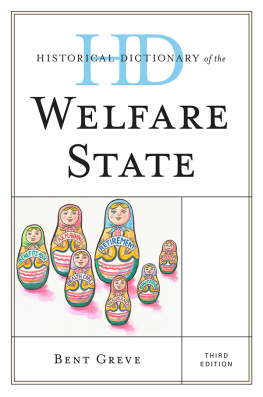When this book was first published in 1987 it was one of a small handful that tried to make sense of the welfare state as a whole not social security specifically or, for example, health care or progressive taxation but the whole edifice of transfers and taxes. I was exploring the democratic welfare state, hence democratic governance, hence democracy.
The Crisis That Didnt Happen
The stiff competition at the time, at least in Europe, was from two books of a more or less Marxist inspiration, Ian Goughs The Political Economy of the Welfare State (1979) and Claus Offes Contradictions of the Welfare State (1984). They, in turn, followed on the heels of James OConnors Fiscal Crisis of the State (1973).
Those authors, the OGouffes as Rudolf Klein called them later, argued that a welfare state could not be sustained within a capitalist economy. Individuals, families, and businesses would be seduced to an ever-escalating demand for goods, benefits, and free services which those same households and enterprises would remain resistant to paying for through the taxes needed to fund their own demand. This would result in a widening gulf between outflows from welfare budgets and inflows into them that was expected, sooner or later, to reach a crisis point. The source of breakdown would be a lack of power in the institutions of democratic rule to clear demands on the state and its ability to fund itself. Hence, the OGouffe prediction was finally about the impossibility of harmony between capitalism and democracy. These two great forces of modernity were pulling in opposite directions and it was only a matter of time before their cohabitation was up and the dream of a society of justice, order, and reason resting on these two pillars would collapse into the void between them.
My approach was pragmatic. I started from no grand theory but, on page one, with an elementary question: Does the welfare state work? Then I set out to answer that question from what I could read out of the empirical evidence, some of my own making and some from existing sources. I looked to poverty and to the distribution and redistribution of income and asked if politics matters. I found that it did. I looked to the other side of the account for economic costs and disruptions in social life and asked if these were prohibitive. I found that they were not. I think I neither exaggerated effectiveness nor denied costs, nor disregarded how different the welfare states of different countries are in build-up and effectiveness, but on balance what was achieved did not seem bad compared to what was sacrificed. In the social sciences, theory is the stuff of the making of good questions but sometimes gets in the way when used as a tool for answering them. I was committed to observing before pronouncing and to, as far as possible, let the facts speak. I think that nave strategy paid off; at least I was able to conclude, in the final paragraph on the final page, that the welfare state does work sort of. The marriage of democracy and capitalism is no doubt a quarrel-some one. The evidence on the welfare state, as I read the balance sheets, was rather that it helped to keep the odd couple together than to drive it apart.
However, it was fully possible then that both I and the OGouffes were right. I looked back from the mid-1980s to what was perhaps the golden age of welfare state expansion. That I found things to have been running reasonably well up to then was no proof that they would continue to run well into the future. It was in that future that the OGouffes predicted crisis and that prediction could not be faulted by looking back into the past.
But we are now twenty to thirty years on and deep into what was then the future. How has it gone? Did the welfare state run into crisis or has it continued to work? The answer, as we shall see, is not straightforward. The predicted crisis never happened but the OGouffe provocation just refuses to go away.
The message of doom was carried forward along two lines. A first line was inspired by the Organisation of Economic Co-operation and Development, the economic club of rich countries, in a grand conference of policymakers and academics (including myself), the material from which was published in The Welfare State in Crisis (1981). The economists at the OECD had concluded that welfare state spending was out of control and that distorting disincentives had been allowed to spread through welfare state arrangements so as to hold back economic growth. It was necessary, they thought, to get ahead of the looming crisis and rein in the welfare state before it was too late. That was bound to be difficult because there was no awareness of crisis and therefore no real motivation in governments and parliaments to take on the trouble of pushing through unpopular decisions. The aim of the conference and the book and its uncharacteristically provocative title for so cautious an organization as the OECD was to create that awareness.
A second line was inspired by political changes, in particular the coming to power of Margaret Thatcher in Britain in 1979 and Ronald Reagan in the United States in 1980. These and other events were seen to usher in a new ideological climate of neo-liberalism or neo-conservatism. That change in ideology, it was thought, was bound to carry through to radical changes in welfare state policies which came to be discussed under labels such as retrenchment or dismantling.
The OECD warning of runaway welfare spending was finally submitted to systematic analysis by Francis Castles in The Future of the Welfare State (2004). He was, as I had been, committed to observing the matter empirically rather than going by what might be suggested theoretically. He took on the OECD on its own turf by reanalyzing, with much ingenuity and cunning, its database on social expenditure, observing spending trends in all of the OECD countries from 1980 to 1998.


